
The Solar-Terrestrial Centre of Excellence (STCE) is a collaborative network of the Belgian Institute for Space Aeronomy, the Royal Observatory of Belgium and the Royal Meteorological Institute of Belgium.
 |
Published by the STCE - this issue : 23 Aug 2012. The Solar-Terrestrial Centre of Excellence (STCE) is a collaborative network of the Belgian Institute for Space Aeronomy, the Royal Observatory of Belgium and the Royal Meteorological Institute of Belgium. |
| Archive of the newsletters | Subscribe to this newsletter by mail |
Solar filaments are clouds of ionized gas above the solar surface squeezed between magnetic regions of opposite polarity. Being cooler and denser than the plasma underneath and their surroundings, they appear as dark lines when seen on the solar disk using special filters. The image below shows such a filament (USET/H-alpha, left - http://sidc.be/uset/ ): the cloud blocks the solar H-alpha radiation leaving a shadow-view of the filament. Its silhouette was added in blue to the magnetogram on the right, clearly marking the borderline between negative (black) and positive (white) magnetic polarities (SDO/HMI, right - http://sdo.gsfc.nasa.gov/ ).
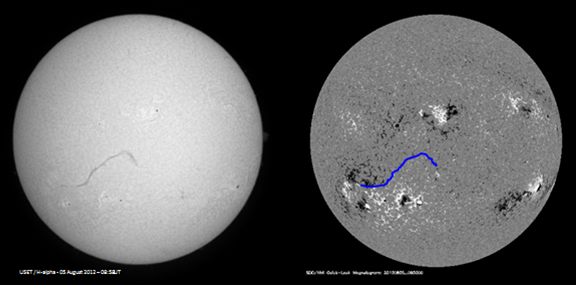
So, when early August a long filament appeared from behind the Sun's southeastern solar limb, it immediately grabbed the attention of the solar observers. The figure underneath shows the Sun on 5 August 2012 at 09:00UT. On the left is a H-alpha view through the USET-telescope, overlaid with a transparent SDO/HMI image (photosphere) showing the location of the filament outside the sunspot regions. The image on the right is made by PROBA2 (http://proba2.oma.be/ ) and shows the same filament as a thin, dark line snaking its way through the much hotter corona.
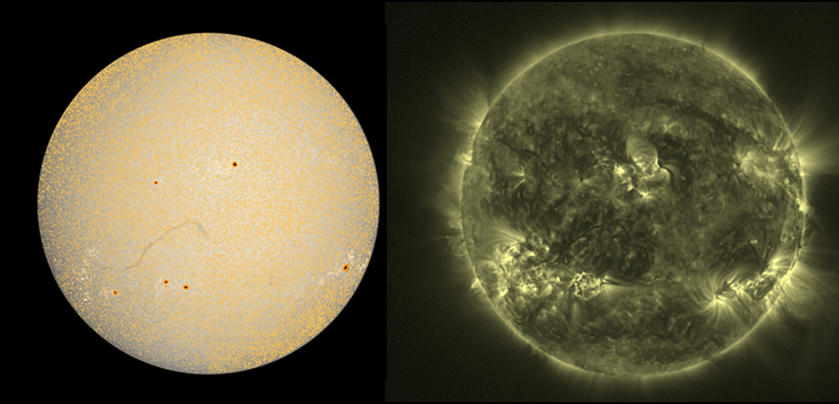
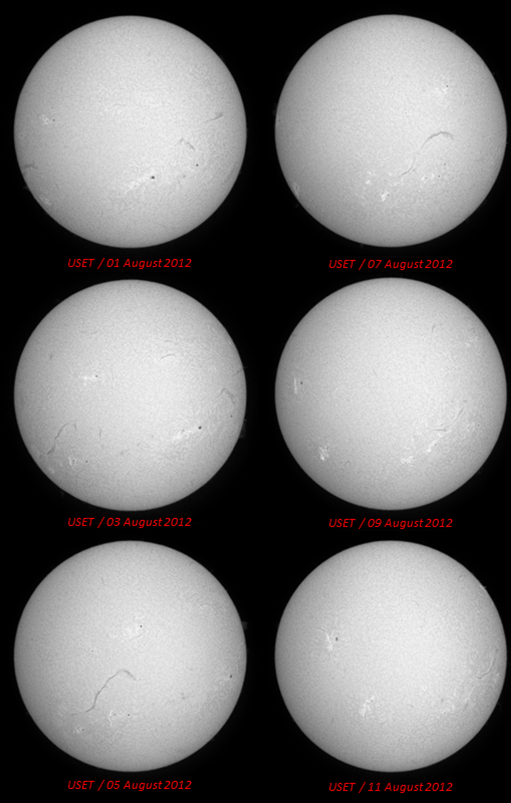
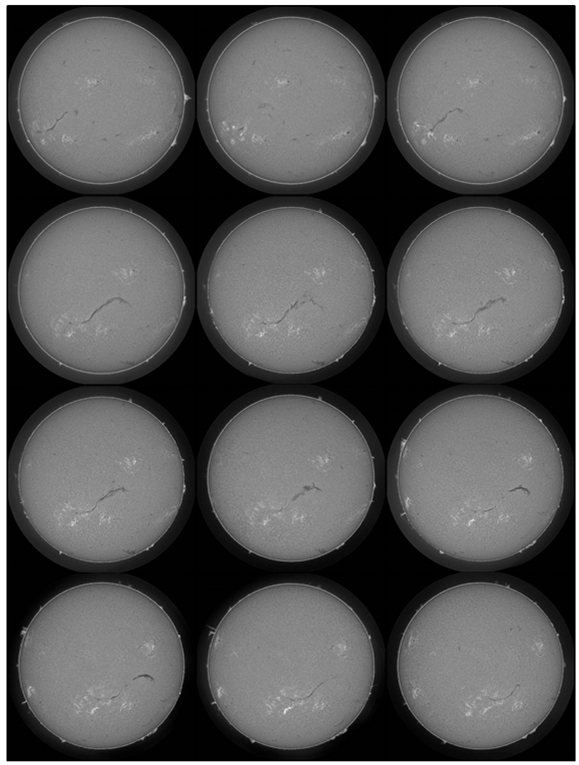
During the afternoon of August 6, first the northern half erupted, restoring itself in the next few hours. Later that day, it was followed by the eruption of the southern part of the filament, which would also restore itself but needing a lot more time to do so. Then, on August 8, the northern part was permanently ejected. All three events were accompanied by weak and slow-moving coronal mass ejections that did not trigger geomagnetic disturbances.
The remaining half of the filament started its 2 weeks solar backside transit on August 14, leaving solar observers wondering if they have to prepare themselves for a sequel to this die-hard solar filament. Coming soon to a telescope near you!
Solar activity was moderate for most of the week with only C-class flares from August 13 till August 17, taking place in active regions NOAA 1542 and 1543. From August 17 till August 19, 7 M-flares (medium class) occurred as active region NOAA 1548 began its transit on the East limb. The strongest event was a M5.5 flare, which happened on August 18, 01:02 UT (peak time). Underneath images made by the Solar Dynamics Observatory (SDO - http://sdo.gsfc.nasa.gov/ ) clearly show that this flare took place while the sunspot region NOAA 1548 was still behind the Sun's limb.
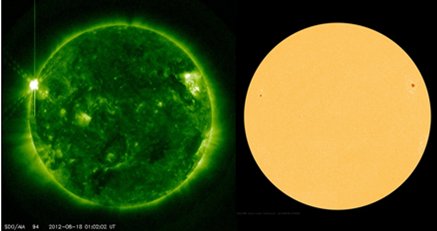
| DAY | BEGIN | MAX | END | LOC | XRAY | OP | 10CM | TYPE | Cat | NOAA | NOTE |
| 17 | 1312 | 1319 | 1323 | M2.4 | 59 | III/2 | 1548 | partially occulted flare | |||
| 17 | 1708 | 1720 | 1727 | M1.0 | 140 | III/2 | 1548 | partially occulted flare | |||
| 18 | 0024 | 0102 | 0107 | N19E86 | M5.5 | SF | 150 | 1548 | |||
| 18 | 0317 | 0323 | 0330 | N19E86 | M1.8 | SN | 100 | 1548 | |||
| 18 | 1602 | 1607 | 1609 | N19E80 | M2.0 | 1N | 56 | III/2 | 1548 | ||
| 18 | 2246 | 2254 | 2300 | N19E78 | M1.0 | SF | 0 | III/1 | 1548 | ||
| 18 | 2315 | 2322 | 2332 | N21E76 | M1.3 | SN | 0 | VI/1 | 1548 |
| LOC: approximate heliographic location | TYPE: radio burst type |
| XRAY: X-ray flare class | Cat: Catania sunspot group number |
| OP: optical flare class | NOAA: NOAA active region number |
| 10CM: peak 10 cm radio flux |
Solar Activity
Early this week, the Sun's activity level was *Low*, until AR 11548 was closing in from behind the east limb. *Moderate* activity was generated by this AR with several M flares on Friday and Saturday (see table above). On Sunday, when the AR had rounded the limb, the activity went back to *Low*.
In order to view the activity of this week in more detail, we suggest to go to the following website from which all the daily (normal and difference) movies can be accessed: http://proba2.oma.be/ssa.
This page also lists the recorded flaring events.
Most of the M flares were occurring behind the east limb on Friday and Saturday and so there was only limited viewing available.
However, another couple of interesting phenomena occurred on Monday 13th as well as around midnight on the 15th and 16th.
Monday 13/08
.png)
Wed/Thu 15-16/08
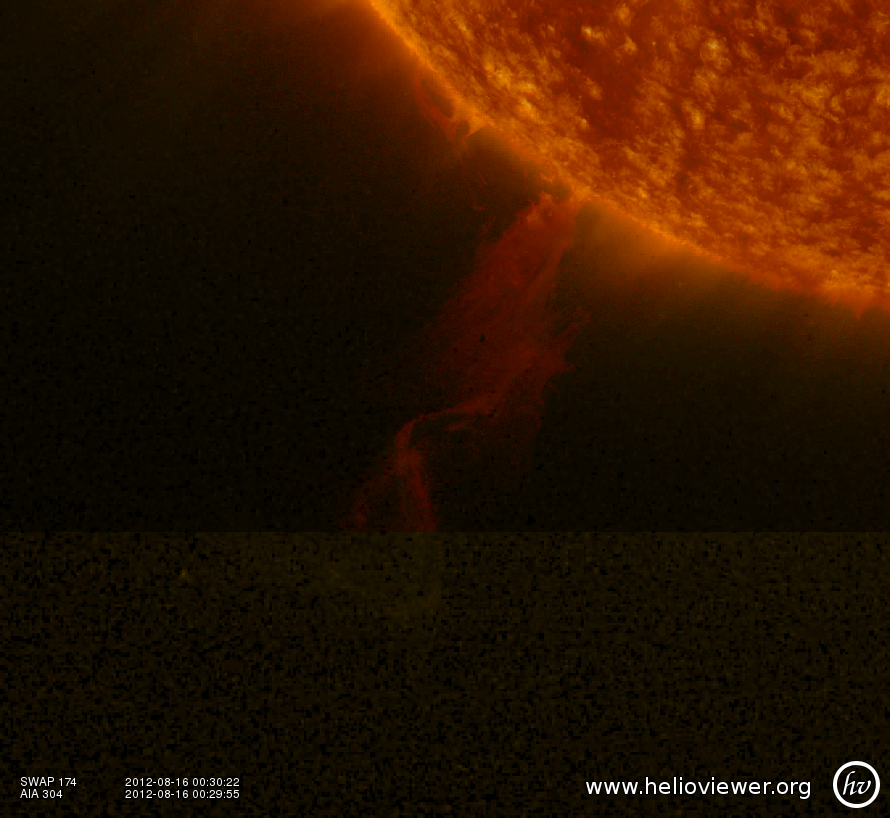
Geomagnetic activity was very low during the week. Unsettled to active conditions (K=3 to 4) were observed locally in Dourbes on August 19 when the Earth entered a fast solar wind stream linked to a coronal hole. A shock signature was observed by ACE on that day around 08:00 UT.
Workshop On-orbit degradation of solar and space weather Instruments – Lesson learned
http://www.spaceweather.eu/en/repository/show?id=223
Workshop On-orbit degradation of solar and space weather Instruments - Lessons learned
http://www.spaceweather.eu/en/repository/show?id=224
Workshop On-orbit degradation of solar and space weather Instruments – Lesson learned
http://www.spaceweather.eu/en/repository/show?id=225
Workshop On-orbit degradation of solar and space weather Instruments – Lesson learned
http://www.spaceweather.eu/en/repository/show?id=226
Workshop On-orbit degradation of solar and space weather Instruments – Lesson learned
http://www.spaceweather.eu/en/repository/show?id=227
Workshop On-orbit degradation of solar and space weather Instruments – Lesson learned
http://www.spaceweather.eu/en/repository/show?id=228
Workshop On-orbit degradation of solar and space weather Instruments – Lesson learned
http://www.spaceweather.eu/en/repository/show?id=229
Workshop On-orbit degradation of solar and space weather Instruments – Lesson learned
http://www.spaceweather.eu/en/repository/show?id=230
Workshop On-orbit degradation of solar and space weather Instruments – Lesson learned
http://www.spaceweather.eu/en/repository/show?id=231
Workshop On-orbit degradation of solar and space weather Instruments – Lesson learned
http://www.spaceweather.eu/en/repository/show?id=232
Workshop On-orbit degradation of solar and space weather Instruments – Lesson learned
http://www.spaceweather.eu/en/repository/show?id=233
Workshop On-orbit degradation of solar and space weather Instruments – Lesson learned
http://www.spaceweather.eu/en/repository/show?id=234
Workshop On-orbit degradation of solar and space weather Instruments – Lesson learned
http://www.spaceweather.eu/en/repository/show?id=235
Workshop On-orbit degradation of solar and space weather Instruments – Lesson learned
http://www.spaceweather.eu/en/repository/show?id=236
Workshop On-orbit degradation of solar and space weather Instruments – Lesson learned
http://www.spaceweather.eu/en/repository/show?id=237
A presentation given at the KULeuven (120 participants) and Kortrijk (80 participants) in the frame of the project Jr College. The presentation introduces the Sun and Space Weather.
http://www.spaceweather.eu/en/repository/show?id=238
A presentation given at the KULeuven (120 participants), Kortrijk (80 participants) in the frame of the project Jr College and Hoogstraten in the frame of PROBA@school. The presentation introduced the development, launch and exploitation of PROBA2 and PROBA2 as a satellite to monitor space weather.
http://www.spaceweather.eu/en/repository/show?id=239
A workshop given in Hoogstraten, Belgium in the frame of the project PROBA2@school. Students of the last year of highschool were instructed to calculate the arrival time at Earth of the wind emanating from a coronal hole and the speed of a CME based on coronographic images of STEREO A and B.
http://www.spaceweather.eu/en/repository/show?id=240
A presentation given for Urania, amateur astronomers (150 participants,Antwerpen) and for habitants of service flats (40 participants, Leuven), Belgium. The Sun as a dynamic star causing space weather was introduced. The facts of PROBA2 and its journey from launch to operations were presented.
http://www.spaceweather.eu/en/repository/show?id=241
PROBA2 Science Days May 2012
http://www.spaceweather.eu/en/repository/show?id=242
http://www.spaceweather.eu/en/repository/show?id=243
PROBA2 Science Days May 2012
http://www.spaceweather.eu/en/repository/show?id=244
PROBA2 Science Days May 2012
http://www.spaceweather.eu/en/repository/show?id=245
PROBA2 Science Days May 2012
http://www.spaceweather.eu/en/repository/show?id=246
PROBA2 Science Days May 2012
http://www.spaceweather.eu/en/repository/show?id=247
PROBA2 Science Days May 2012
http://www.spaceweather.eu/en/repository/show?id=248
PROBA2 Science Days May 2012
http://www.spaceweather.eu/en/repository/show?id=249
PROBA2 Science Days May 2012
http://www.spaceweather.eu/en/repository/show?id=250
PROBA2 Science Days May 2012
http://www.spaceweather.eu/en/repository/show?id=251
Start : 2012-08-27 - End : 2012-09-21
The Solar and Space Weather
Network of excellence will hold its
first Summer School and Workshop in Tbilisi Georgia. The meeting
will focus on the first results achieved within the network and is
also open to the wider international scientific community involved
in solar and space weather
modeling, monitoring and
forecasting activities.
The Summer school will be open to all early-stage researchers
from the SOLSPANET member groups as well as to other young
scientists from institutes active in solar and space weather
studies.
The week of September 17-21 will be dedicated to the
International SOLSPANET-1 workshop. The workshop is also devoted to
the memory of the great Georgian scientists, professors Rolan
Kiladze and Avtandil Pataraya.
Scientific topics will include:
* Monitoring of precursors for solar flares and CMEs- solar
weather
* MHD waves in non-equilibrium medium
* Numerical and observational studies of CMEs
* CME
manifestation in the decametre
wavelength band
* Impact of space weather
on terrestrial life and
technological systems
* Advanced computational tools and knowledge base for better
solar and spaceweather forecasting
Website:
http://www.solspanet.eu/solspanet
Start : 2012-09-02 - End : 2012-09-08
The International School of Space Science of the Consorzio
Interuniversitario per la Fisica Spaziale organizes a Course on
"Astrophysical and Space Plasmas", to be held in L'Aquila, Italy,
September 02-08, 2012, and directed by A. Ferrari, M. Tavani, B.
Coppi and R. Rosner.
The aim of the Course is to present a comprehensive discussion
of the plasma
processes relevant to the
astrophsyical context, from low energy phenomena in planetary
systems to the very high energy objects recently discovered through
X and gamma ray observatories.
Introductory lectures will be dedicated to an analysis of
observations available from ground and space observatories
enlightening the thermal and non-thermal plasma
processes necessary for their
interpretation. At the same time the theoretical tools, analytical
and numerical, necessary for their interpretation will be presented
from an institutional point of view. Finally current models of the
astrophysical objects and phenomena will be discussed with
particular attention to the critical points with the objective of
selecting new research lines.
Website:
http://www.cifs-isss.org/
Start : 2012-09-04 - End : 2012-09-07
The Fourth HELIO Coordinated Data Analysis Workshop (CDAW) will
be held during September 2012 in the School of Physics of Trinity
College Dublin.
The purpose of this CDAW is to provide an opportunity for the
heliophysics community to learn about the capabilities of HELIO and
discover how they can be used to address science use cases.
Feedback from the CDAWs also help us determine how the HELIO
infrastructure should be extended.
The goal of the workshop is to exercise the HELIO infrastructure
based on a selection of use cases and verify of the functionality
of the services and their level of integration.
The general objective is to exercise the infrastructure by
studying use cases that require observations made at multiple
points in the Solar System, as e.g. propagation studies of CMEs and
SEPs from their solar source toward 1 AU and beyond.
One specific objective is to examine how well the propagation
tools that we are developing actually help determine the timing of
the required remote sensing and in-situ observations. This will
help us identify what improvements and developments are required
for this capability.
Website:
http://helio-vo.eu/helio-cdaw/HELIO_CDAW-4.html
Start : 2012-09-10 - End : 2012-09-14
The Summer school is part of the training program of the Marie
Curie Initial Training Network TRANSMIT, funded by the European
Commission. Young scientists involved in TRANSMIT shall be trained
and educated for being aware and getting basic understanding of
ionospheric threats in different fields of application. Awareness
and knowledge of ionospheric threats is the starting point of
subsequent work to reduce or mitigate them in practical
applications.
Well recognized experts in their fields will give lectures to
better understand/learn about:
* Physical nature of ionospheric perturbations at all scales
* Ionospheric impact on radio wave propagation
* Detection/Monitoring of ionospheric perturbations
* Estimation the degree of ionospheric perturbation
* Mitigation techniques for avoiding threats in technical
systems
It is expected that lectures and discussions at the summer
school will help in particular early stage researchers to improve
their scientific work.
Website:
http://www.transmit-ionosphere.net/
Start : 2012-09-10 - End : 2012-09-14
We are pleased to announce that the fifth Solar Orbiter Workshop
will take place in Brugge, Belgium from Monday September 10 to
Thursday September 13. Friday September 14 will be dedicated to a
Science Working Team (SWT) meeting. The workshop will focus on the
science questions addressed by this exciting and recently approved
mission, which is a partnership between ESA
and NASA
. The scientific synergy of Solar
Orbiter with Solar Probe Plus and other missions will also be
highlighted.
Website:
http://www.stce.be/solarorbiter5/
Start : 2012-09-17 - End : 2012-09-22
The School of Astrophysics 'Francesco Lucchin' is addressed to
PhD students in Astronomy and Physics, as well as to interested
young researchers. The school aims at providing a comprehensive
background in Astronomy and Astrophysics, from both a theoretical
and an observational point of view.
The main purpose of the school is to provide common cultural
ground on hot topics of research, both observational and
theoretical, to young astronomers. This will reveal the potential
links between the various projects in which the PhD students and
young researchers are involved, and encourage collaborative
research for the future.
The school is open to students and young researchers of all
backgrounds (experimental, observational, theoretical).
The topics of the school are:
* The Sun: a Plasma
Physics Laboratory (Chair:
Francesca Zuccarello)
* Formation of the solar system: clues from exploration (Chair:
Priscilla Cerroni)
Website:
http://www.iasf-roma.inaf.it/IAPS/AstroSchool/
Start : 2012-09-17 - End : 2012-09-26
The International Space Weather
Initiative (ISWI) is a program of
international cooperation to advance the space weather
science by a combination of
instrument deployment, analysis and interpretation of space weather
data from the deployed instruments
in conjunction with space data, and communicate the results to the
public and students. ISWI is a follow-up activity to the successful
IHY 2007, but focusing exclusively on space weather
. The goal of the ISWI is to
develop the scientific insight necessary to understand the science,
and to reconstruct and forecast near-Earth space weather
. This includes instrumentation,
data analysis, modeling, education, training, and public outreach.
ISWI has conducted many programs not only to popularise space
science all over the world but also to create favorable conditions
for joint research and training in some sort of global framework.
In the framework of IHY and ISWI, some research groups have been
established in several countries. In order to establish the strong
space research group, particularly in Asia-Oceania countries, a
training to the young students and researchers is necessary. In the
framework of this program, the Space Science Center of National
Institute of Aeronautics and Space (LAPAN) is honored to host the
2012 ISWI and MAGDAS School in Space Science, the school to young
solar physicists and geophysicists, to be held on 17-26 September
2012 in Bandung Indonesia.
Website:
http://iswimagdas2012.dirgantara-lapan.or.id/
Start : 2012-09-18 - End : 2012-09-19
The 2012 Solar Radiation and Climate Experiment (SORCE) Science
Meeting examines modeling efforts to understand solar spectral
irradiance (SSI) variability, in terms of both its origins in the
solar atmosphere and its impact on Earth's climate and atmosphere.
In solar physics, advancements in radiative transfer, surface
feature identification, dynamics and how observations of solar
magnetic fields and irradiance all lead to an improved
understanding of the mechanisms of irradiance change.
Earth-atmospheric general circulation models (GCM) incorporating
sophisticated codes for chemistry, radiation, dynamics, and
feedback mechanisms associated with clouds, aerosols, and ocean
processes are able to address the role of SSI variability in
climate. In both cases, comparisons with observations lead to a
deeper understanding of the dynamic solar atmosphere and our
complex Earth climate system.
Website:
http://lasp.colorado.edu/sorce/news/2012ScienceMeeting/
Start : 2012-09-18 - End : 2012-09-20
In-situ observations by spacecraft provide [note in no
particular order] the ground truth for comparison and constraining
models, have transformed our ideas of the heliosphere
, provide a natural laboratory for
plasma
physics, have challenged our
pre-conceived ideas, and have discovered completely unexpected
phenomena. This workshop will focus on in-situ observations of the
heliosphere
made by the unprecedented suite of
instruments currently returning observations, including the STEREO
spacecraft, near-Earth spacecraft
(ACE,WIND
, SOHO
) and the Voyager spacecraft that
are probing the region approaching the heliopause. It is a follow
on from the ACE/WIND
/STEREO
... workshop held in Kennebunkport
in June 2010. The program will include an overview of recent
results from current missions, invited presentations, and splinter
sessions with a heavy emphasis on discussion. These sessions will
focus on the solar cycle variations, solar wind
, solar energetic particles,
suprathermal ions, coronal and interplanetary transients, and
anomalous and galactic cosmic rays.
Website:
http://stereo.ssl.berkeley.edu/meetings/Sept.2012meeting/
Start : 2012-09-20 - End : 2012-09-23
Every year, the International Meteor
Organization (IMO) organizes the
International Meteor
Conference (IMC). This conference
deals with all aspects of meteor
observation as well as the
underlying physics and is aimed at both amateurs and
professionals.
The International Meteor
Organization (IMO) will hold the
31st annual International Meteor
Conference (IMC) on La Palma,
Canary Islands, Spain, from 20 till 23 September, 2012. The
conference will be organized by the Astro Travels agency in
collaboration with the Cabildo of La Palma island authority which
will sponsor this event.
Website:
http://www.imo.net/imc2012/
Start : 2012-09-24 - End : 2012-09-28
The 21st European Conference on RADIATION AND ITS EFFECTS ON
COMPONENTS AND SYSTEMS will be held in Biarritz, France, on
September 24-28, 2012.
The aim of RADECS conferences is to provide an annual European
forum for the presentation and discussion of the latest advances in
the field of radiation effects on electronic and photonic
materials, devices, circuits, sensors, and systems. The scope of
the conference encompasses technological processes and design
techniques for producing radiation tolerant systems for space,
aeronautical or terrestrial applications, as well as relevant
methodologies for their characterization and qualification. The
conference features a technical program, an Industrial Exhibit, and
one day meeting on ground effects offered on September 24
(RADGROUND). The technical program includes oral and
postersessions.
The areas of interest for contributions to be submitted to
RADECS 2012 include, but are not limited to:
* Basic mechanisms of radiation effects in electronic and
optical materials
* Space, atmospheric and terrestrial environments
* Radiation effects on electronic and photonic devices, circuits
and systems
* Radiation effects on sensors and emerging devices
* Technology and design hardening
* Radiation hardness assurance
* Irradiation facilities and testing
Website: http://radecs2012.org
Start : 2012-10-01 - End : 2012-10-05
At the forthcoming 63rd International Astronautical Congress in
Naples a special session on the theme 'Effects of Space Weather
on GEO
Satellites' will be held as part of
the 25th Symposium on Space Policy, Regulations and Economics.
This session will discuss case histories and mechanisms of
effects of space weather
on GEO
satellites, models for prediction,
and mitigation approaches. We would like to invite you to consider
submitting abstracts for this session.
The call for papers can be found at
The
deadline for abstract submission is 29 February 2012.
http://www.iafastro.org/docs/2012/iac/IAC2012_CallForPapers.
Website: http://www.iac2012.org/
Start : 2012-10-08 - End : 2012-10-12
Initiated in 1990, the United Nations Basic Space Science
Initiative (UNBSSI) has contributed to the international and
regional development of astronomy and space science through annual
workshops organized under the umbrella of the United Nations,
focusing specifically on the International Heliophysical Year 2007
(IHY, 2005-2009) and the International Space Weather
Initiative (ISWI, 2010-2012).
UNBSSI has led to the establishment of planetariums, astronomical
telescope facilities, and IHY/ISWI instrument arrays worldwide,
particularly in developing nations. ISWI is envisioned to continue
the tradition of IHY in the worldwide deployment of space weather
monitoring instrument arrays. To
date, ISWI contributes to the observation of space weather
through 18 instrument arrays with
close to 1000 operating instruments in more than 100 nations
supported by designated national ISWI coordinators.
The first workshop on ISWI was held in Helwan, Egypt and hosted
by the Helwan University, Egypt, in 2010, particularly for the
benefit of nations in Western Asia. In 2011 the United
Nations/Nigeria Workshop on ISWI was hosted by the Centre for Basic
Space Science of the University of Nigeria at Nsukka, Nigeria,
particularly for the benefit of nations in Africa. The third ISWI
workshop will be hosted by Ecuador in 2012 for the region of Latin
America and the Caribbean.
Website:
http://iswiecuador.epn.edu.ec/
Start : 2012-10-22 - End : 2012-10-24
2012 - 2013 is expected to be years with high solar activity.
This can trigger larger solar storms which can generate geomagnetic
induced currents (GIC
) on the earth. GIC
can affect the normal operation of
specific industrial operations and critical infrastructure (e.g
power grids, telecom, navigation systems, etc).
During space weather
events, like solar storms, electric
currents in the magnetosphere
and ionosphere
experience large variations, which
manifest also in the earth's magnetic field. These variations
induce currents (GIC
) in conductors operated on the
surface of the earth. Electric transmission grids and buried
pipelines are common examples of such conductor systems. GIC
can cause problems, such as
increased corrosion of pipeline steel and may disturb and possible
damaged high-voltage power transformers and it can also have
damaging effects on communication systems, navigation systems and
oil and gas operations.
Vulnerable industries are the oil and gas industry, railways,
telecommunication industry, navigation industry and not at least
the society, which is very vulnerable concerning short or long term
interruption of critical infrastructure.
The conference will focus on increasing the general knowledge of
solar storms, space weather
and GIC
and the possible consequences for
different industries and critical infrastructure, and look into
reasonable means of protection, and consider possible early warning
solutions.
Website:
http://www.tiems.info/about-tiems/oslo-conference-2012.html
Start : 2012-11-05 - End : 2012-11-09
We are pleased to announce that the Ninth European Space Weather
Week will take place at the
Académie Royale de Belgique, Brussels, Belgium between 5
and 9 November 2012.
This meeting is being jointly organised by the Solar-Terrestrial
Centre of Excellence (STCE), ESA
, the SWWT and the COST ES0803
communities. The local organisation is done by the STCE. This event
will continue to build on the advances made during the first eight
European Space Weather
Weeks held between 2004 and
2011.
Website:
http://www.sidc.be/esww9/
Start : 2012-11-06 - End : 2012-11-09
The International Symposium on Solar-Terrestrial Physics will be
held during November 6 - 9, 2012 at the Indian Institute of
Science, Education and Research, Pune, India. This meeting under
the aegis of the SCOSTEP is expected to draw leading scientists
from around the world in the increasingly important,
interdisciplinary fields of Solar activity and its impact on
geospace and life on the Earth. With major observational solar
facilities being planned in India, this meeting is especially
pertinent in the Indian context.
The meeting is expected to involve professional scientists as
well as graduate students, and will have a mixture of invited and
contributed talks and posters. There will also be a one-day
tutorial for the benefit of young people beginning work in the
field of solar-terrestrial physics.
Website:
http://www.iiserpune.ac.in/~isstp2012/
Start : 2012-11-12 - End : 2012-11-16
As we emerge from one of the deepest and longest solar minima on
record, with a new and powerful eye on the Sun -SDO- we invite all
those with an interest is solar activity to gather in beautiful
Palm Cove, Australia to review and assess our current knowledge and
understanding of our magnetic star
, and to experience the awe and
wonder of a total solar eclipse on November 14, 2012.
Website:
http://moca.monash.edu/eclipse/
Start : 2012-11-13 - End : 2012-11-13
For more information:
http://eclipse.gsfc.nasa.gov/OH/OH2012.html#SE2012Nov13T
Start : 2012-11-15 - End : 2012-11-16
The European Commission will organise the 'Let's embrace
space - FP7 Space Conference 2012', in cooperation with the Cypriot
EU Presidency, on 15 and 16 November 2012 in Larnaca, Cyprus.
This scientific conference will present the current status and
results of the 3rd call of FP7 space research, and also discuss
future options for European research in the space field. In doing
so, the conference will aim at demonstrating the evolution and use
of space tools for a sustainable economic and environmental
development in a European and global context.
Website:
http://www.fp7-space.eu/news-119.phtm
Start : 2012-11-20 - End : 2012-11-23
Nobeyama Radioheliograph (NoRH) has been observing the Sun since
1992. This year is the 20th year of science operation. Instruments
are still in good shape and producing images of the Sun every day
with the same quality as the beginning. Due to the nature of the
instrument and long and uniform observations, data can be used for
wide variety of solar physics and also for solar terrestrial
physics. To mark the 20 years of operation, we will organize a
symposium to summarize what has been done with NoRH and to discuss
what we should do in the future. Papers to be presented in the
meeting will be mainly concerned with the results from NoRH and
future plans.
Website:
http://st4a.stelab.nagoya-u.ac.jp/SPRO2012/
Start : 2012-11-30 - End : 2012-12-05
The overarching objective of the conference is to examine the
connections amongst the phenomena that lead to solar eruptive
events. The current state of themes includes:
* Measuring the Coronal Magnetic Field;
* Connections to, and Reactions of, the Large-Scale Corona;
* Large-scale Magnetic Connectivity of Active Regions;
* Transfer of Energy to, and Storage of Energy in, the
Corona;
* The High-Energy Particle - Flare - CME
connection.
Working groups will address topics such as:
* Energy Transfer throughout a Solar Eruptive Event;
* Global Energetics of an Ensemble of Events;
* Coronal Influences to the Lower Atmosphere;
* CME
Initiation and Type II Bursts;
* The Release of Energetic Particles in the Low Corona;
* Flows vs. Waves;
* Microflares/Nanoflares.
Website:
http://hessi.ssl.berkeley.edu/petaluma/index.shtml
Start : 2013-01-13 - End : 2013-01-19
Information coming soon!
Website:
http://sd-www.jhuapl.edu/Aurora/ESSE/index.html
Start : 2013-03-03 - End : 2013-03-08
Living With a Star
's Solar Dynamics Observatory
invites you to its 2013 Science Workshop to be held March 3-8, 2013
at the Hyatt Regency Chesapeake Bay in Cambridge, MD
(http://chesapeakebay.hyatt.com/). The workshop is a follow-on to
the 'Many Spectra of Solar Activity' workshop held May 1-5, 2011 in
Squaw Valley, CA.
Scientific sessions will feature a broad spectrum of science
topics fundamental to SDO's science investigations:
Atmospheric Imaging Assembly (AIA), EUV Variability Experiment
(EVE), and Helioseismic and Magnetic Imager (HMI), as well as the
overlap between SDO and other scientific missions and
activities.
Website:
http://lws-sdo-workshops.org/
Start : 2013-03-10 - End : 2013-03-15
Spacecraft observations have established that all magnetized
planets in our solar system interact strongly with the solar wind
and possess well-developed
magnetotails. Magnetotails are the site for many dynamic processes
critical to the circulation of mass, energy and magnetic flux. The
great differences in solar wind
conditions, planetary rotation
rates, ionospheric conductivity, and physical dimensions from
Mercury's small magnetosphere
to the giant magnetospheres of
Jupiter and Saturn provide an outstanding opportunity to extend our
understanding of the influence of these factors. Therefore, this
Chapman conference will provide a forum in which various
communities can come together and discuss recent achievements of
observational, theoretical, and modeling studies with the objective
to develop a deeper understanding of fundamental properties and
processes of planetary magnetotails through a comparative
examination.
Start : 2013-05-10 - End : 2013-05-10
For more information:
http://eclipse.gsfc.nasa.gov/SEplot/SEplot2001/SE2013May10A.GIF
Start : 2013-06-10 - End : 2013-06-16
Topics:
* Prominences : formation, dynamics
* Prominence plasma properties, including prominence
seismology
* Magnetic field : measurements, topology, support
* Large-scale patterns and cyclic evolution
* Prominence destabilization, CMEs, reconstruction in 3D
* ICMEs in the heliosphere, magnetic clouds; their impact on the
Earth environment
* Stellar quiescent and eruptive prominences and stellar CME
* Requirements for future instrumentation and prospects for
future missions
Website:
http://www.iau.org/science/meetings/future/symposia/1065/
Start : 2013-06-24 - End : 2013-06-29
Solar cycle 24 has opened a new era in solar radio physics as we
now have instruments that can probe solar processes from
sub-millimeter to kilometer waves. ALMA and LOFAR are entering
full-operation state and observations of the Sun will be made in
the near future.
At the same time extensive use is being made of radio
spectrometers in space, STEREO
/WAVES and Wind
-WAVES, and existing and upgraded
ground-based instruments like Nobeyama Radioheliograph, Nancay
Radioheliograph, Ratan, SSRT, and many others. These instruments
provide data that enable studies of both energetic particles and
thermal plasma
, enhancing our knowledge of solar
eruptions and acceleration and propagation of particles, all
through the solar chromosphere
and corona and into interplanetary
space.
The CESRA 2013 Workshop will highlight these new observational
capabilities and discuss the theoretical issues connected to solar
radio emission and interplanetary radio physics.
Website:
http://wave.asu.cas.cz/cesra2013/
Start : 2013-11-03 - End : 2013-11-03
For more information:
http://eclipse.gsfc.nasa.gov/SEplot/SEplot2001/SE2013Nov03H.GIF